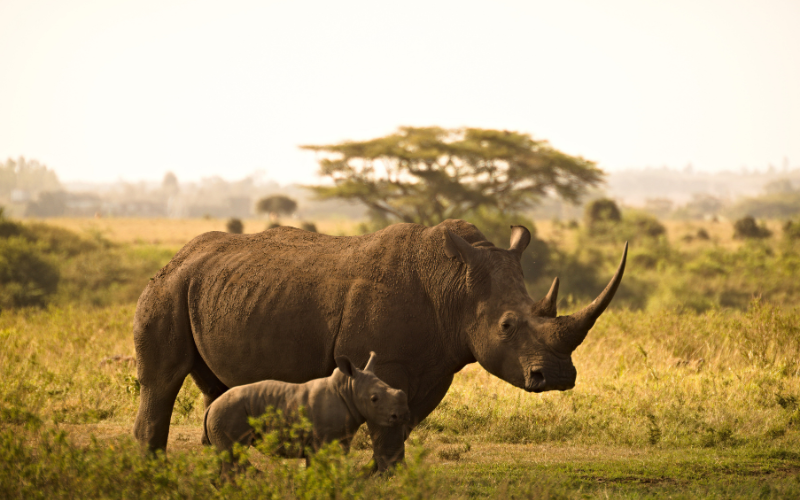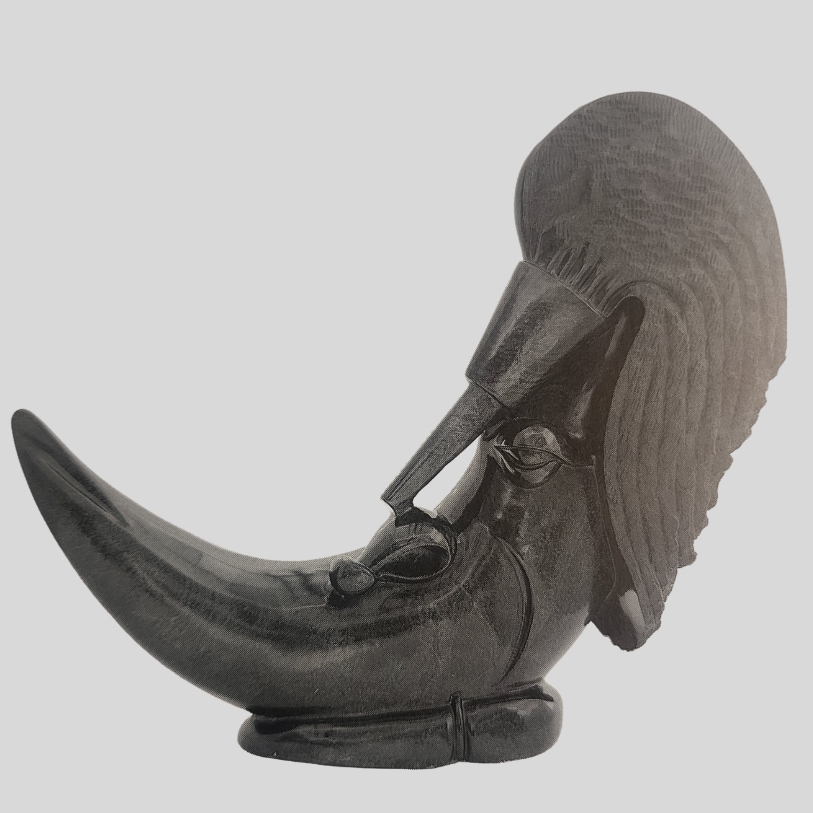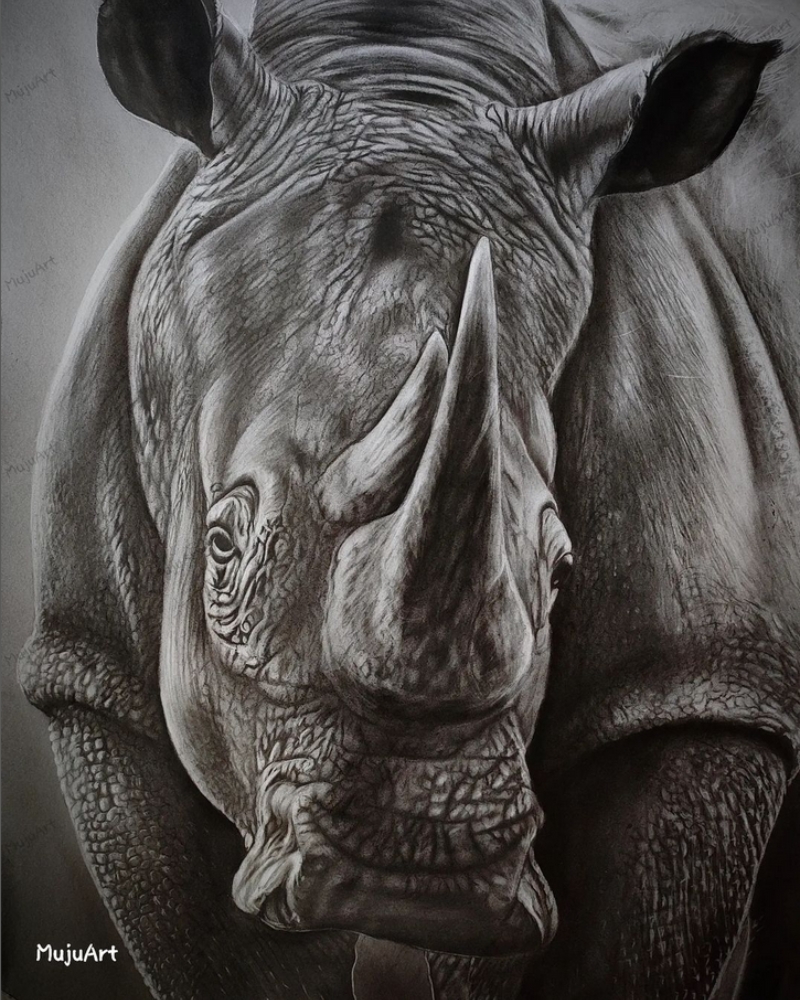Discovering Rhinos during your Holidays in Zimbabwe
Rhinos are massive, plant-eating mammals found in Africa and Asia. There are five distinct species of rhinos, including the black and white rhino. They are notable for their sturdy skin and keratin horn, which helps them to maintain the balance of their habitats through grazing and seed dispersal.

During your holidays in Zimbabwe, on a safari, you will have the opportunity to discover and see both the black and the white Rhino. The white rhino can reach up to 2,250 kg (5,000 lbs), while the black rhino weighs between 450 to 816 kg (1,000 to 1,800 lbs). Males tend to be larger, but weight varies based on factors such as age, health, and overall well-being. Rhinos are among the largest land mammals and are considered one of the most massive animals on earth.
Though they're not known for speed, rhinos are surprisingly nimble and can run up to 50 km/h (31 mph) for short distances, making them formidable when threatened. They're also highly agile and can make sharp turns and sudden movements, despite their slow speed. Rhinos should be respected and given ample space, as they are known to be aggressive when threatened and use their horn as a weapon.
Rhinos are herbivores and primarily eat grasses, leaves, shoots, and branches. The specific diet of a rhino depends on its species, habitat, and availability of food. Black rhinos, for example, eat a variety of woody plants, while white rhinos have a more grass-based diet. Rhino calves typically feed on their mother's milk for the first year of their lives.
Shona sculpture is a popular art form in Zimbabwe, and many artists use the rhino as inspiration. For example, the Rhino Spirit Man. This Shona sculpture was sculpted by Sampson Kuvenguhwa and is a beautiful example of this art form.

If you find yourself facing a rhino in the bush during your holidays in Zimbabwe, it's important to remain calm and still. Do not run, as the rhino can charge at speeds of up to 35 mph (56 km/h), and its sharp horn can cause serious injuries or death.
Here are some tips to help you stay safe when encountering a rhino:
Stand your ground: Try not to move, and avoid making loud noises or sudden movements that may agitate the animal.
Give the rhino space: If possible, slowly back away while keeping an eye on the rhino. Keep a distance of at least 30 meters (100 feet) or more, and avoid getting between a female rhino and her calf.
Be aware of your surroundings: Look for nearby trees, rocks, or other objects that you can use as a barrier or hiding spot in case the rhino charges.
Avoid direct eye contact: Direct eye contact can be seen as a threat to the rhino, so it's best to keep your gaze down or to the side.
Seek help: If the rhino charges and you are unable to escape, try to find a tree or other solid object to hide behind. If you have a mobile phone or other means of communication, call for help immediately.

The Rhino
Charcoals on paper
Rhinos are gentle creatures. ❤️ It's so sad that these innocent beautiful animals are on verge of extinction....lest we join hands and protect them.
They have been around for millions of years and their only real threat is humans.
Say no to poaching.
I just played my part as a pencil Knight , play yours. ❤️ Tonderai Mujuru
Enjoy a short Video on Rhinos in their natural habitat.

It is also more sensible to collect a good Shona sculpture of a Rhino during your holidays in Zimbabwe than to get too close to the animals. Wild animals are dangerous!
Discovering Rhinos during your Holidays in Zimbabwe
Rhinos are massive, plant-eating mammals found in Africa and Asia. There are five distinct species of rhinos, including the black and white rhino. They are notable for their sturdy skin and keratin horn, which helps them to maintain the balance of their habitats through grazing and seed dispersal.

During your holidays in Zimbabwe, on a safari, you will have the opportunity to discover and see both the black and the white Rhino. The white rhino can reach up to 2,250 kg (5,000 lbs), while the black rhino weighs between 450 to 816 kg (1,000 to 1,800 lbs). Males tend to be larger, but weight varies based on factors such as age, health, and overall well-being. Rhinos are among the largest land mammals and are considered one of the most massive animals on earth.
Though they're not known for speed, rhinos are surprisingly nimble and can run up to 50 km/h (31 mph) for short distances, making them formidable when threatened. They're also highly agile and can make sharp turns and sudden movements, despite their slow speed. Rhinos should be respected and given ample space, as they are known to be aggressive when threatened and use their horn as a weapon.
Rhinos are herbivores and primarily eat grasses, leaves, shoots, and branches. The specific diet of a rhino depends on its species, habitat, and availability of food. Black rhinos, for example, eat a variety of woody plants, while white rhinos have a more grass-based diet. Rhino calves typically feed on their mother's milk for the first year of their lives.

Shona sculpture is a popular art form in Zimbabwe, and many artists use the rhino as inspiration. For example, the Rhino Spirit Man. This Shona sculpture was sculpted by Sampson Kuvenguhwa and is a beautiful example of this art form.
If you find yourself facing a rhino in the bush during your holidays in Zimbabwe, it's important to remain calm and still. Do not run, as the rhino can charge at speeds of up to 35 mph (56 km/h), and its sharp horn can cause serious injuries or death.
Here are some tips to help you stay safe when encountering a rhino:
Stand your ground: Try not to move, and avoid making loud noises or sudden movements that may agitate the animal.
Give the rhino space: If possible, slowly back away while keeping an eye on the rhino. Keep a distance of at least 30 meters (100 feet) or more, and avoid getting between a female rhino and her calf.
Be aware of your surroundings: Look for nearby trees, rocks, or other objects that you can use as a barrier or hiding spot in case the rhino charges.
Avoid direct eye contact: Direct eye contact can be seen as a threat to the rhino, so it's best to keep your gaze down or to the side.
Seek help: If the rhino charges and you are unable to escape, try to find a tree or other solid object to hide behind. If you have a mobile phone or other means of communication, call for help immediately.

The Rhino
Charcoals on paper
Rhinos are gentle creatures. ❤️ It's so sad that these innocent beautiful animals are on verge of extinction....lest we join hands and protect them.
They have been around for millions of years and their only real threat is humans.
Say no to poaching.
I just played my part as a pencil Knight , play yours. ❤️ Tonderai Mujuru

It is also more sensible to collect a good Shona sculpture of a Rhino during your holidays in Zimbabwe than to get too close to the animals. Wild animals are dangerous!